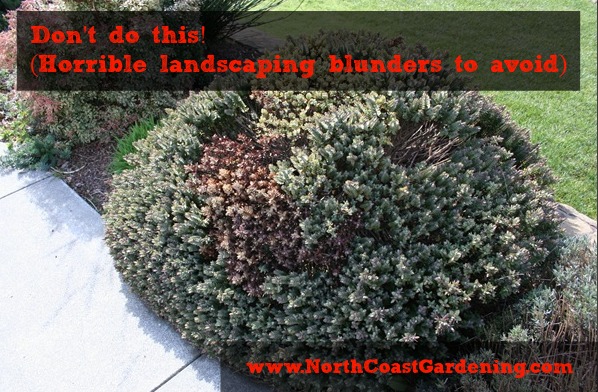
This post might get a little ugly. Scratch that. It’s definitely getting ugly. Today, I’ve got a quick round up of some of the worst offenders I’ve seen in professionally installed landscapes. Roving bamboo, landscape fabric stifling tree trunks, unhappy plants suffering a variety of maladies. . . and all of it easily preventable.
Want to keep from making some of these landscaping mistakes? Read on for a quick, unattractive tutorial.
Don’t strangle your plants with landscape fabric
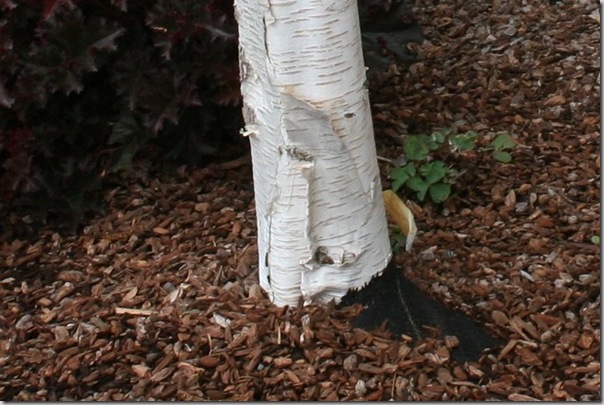
Nothing like enjoying the beautiful white bark of a lovely white birch, then following the line of the trunk to the base, and. . . What is that? Black woven plastic girdling the trunk of your elegant plant?
Just – no. It’s not that hard. Anticipate that your plants will grow and cut out a bigger hole. This goes doubly for ornamental grasses like Miscanthus, which flop unattractively and become impossible to dig and divide when a 3′ wide base of grass is growing out of a 1′ wide hole.
Goodness, where to start? Three don’ts in one.
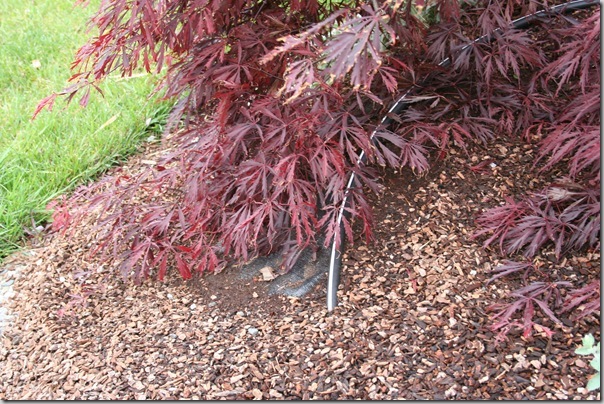
First, be cautious of using landscape fabric on a mound. You see the mulch tends to slide off and expose the black stuff, which is tres tacky.
Second, try to put thick irrigation tubing on a flat region of the garden bed rather than on a mound. Let’s work with gravity here and place the tubing where the mulch will naturally fall to cover it, not slip and expose it.
Lastly, weeping plants tend to move around and brush the mulch off the landscape fabric. There are a number of ways you can prevent your landscape fabric from showing when using weepers like this Japanese maple. First, don’t put the weeper on a mound, where the mulch is already likely to slip off. Second, don’t use landscape fabric in that particular zone. The mulch adheres to soil much better than to slippery-slidey plasticky stuff and anyway, a little exposed soil is no big deal. Third, plant a few groundcovers close enough that their foliage can obscure the fabric should it become exposed.
(More tips on using landscape fabric effectively here, here and here.)
Choose bamboo varieties carefully and don’t plant without a barrier
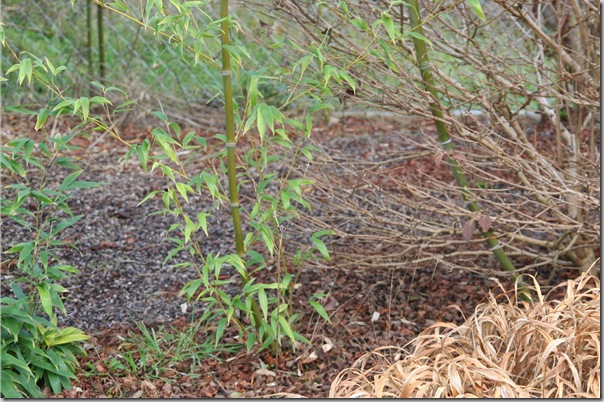
OK, so there are spreading bamboos and clumping bamboos. When you plant a spreading bamboo, use some manner of barrier to keep it from escaping and eating your home. And while you may think a “clumping” bamboo is safe, the owner of my local bamboo specialty nursery says that even with clumping bamboos, you should use a barrier, as nearly every bamboo has thug potential in time.
What barrier, you may ask? They sell rolls of very sturdy plastic that can be buried and used to create a 3′ deep trough of any shape and size you wish. Or you can pour a special concrete pot underground for it. Whatever you do, do not let your bamboo go wild and free. Even with a barrier, it may escape, and you’ll need to make sure it doesn’t jump over the top of your barrier and get a foothold in the surrounding landscape. This is what can happen if it gets out (photos from a local parking lot):
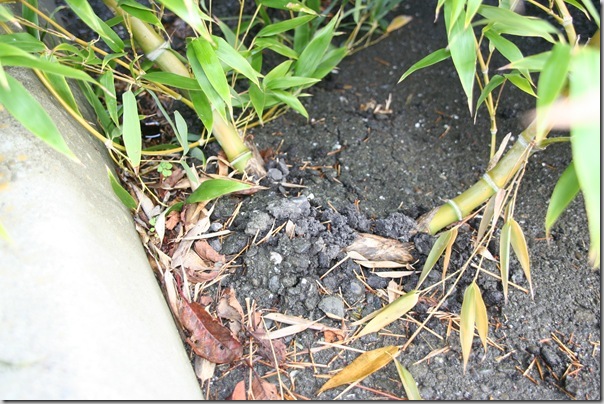
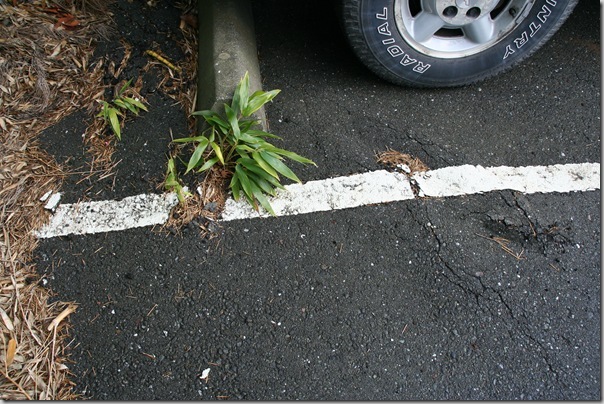
Whew. Scared yet? I am. I like to plant bamboo in pots. Pots which I place on concrete.
Don’t plant heathers or hebes next to sidewalks
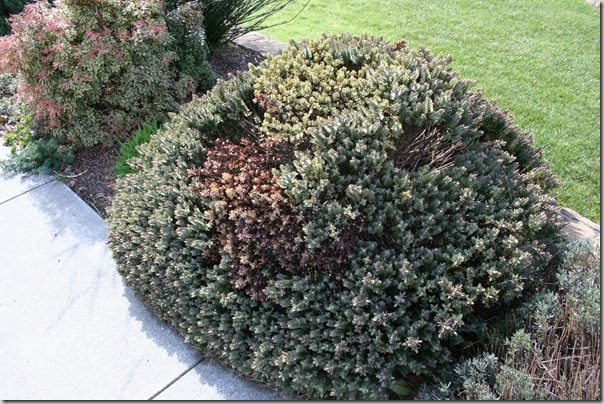
All right, so this one’s not intuitive. But I’ve found that pretty much every variety of Hebe and heather, particularly the finer-leaved ones, are very susceptible to dog urine. I mean, no plant likes to be peed on. But plants with a fine texture tend to hold onto any liquids that fall on them.
When a larger-leaved plant is peed on, the liquid just rolls off and it takes a lot more urine to damage the plant for good. But if the urine lingers and doesn’t roll off, like with the fine-leaved texture of this Hebe above, then you have a recipe for icky dead patches that don’t regenerate. Just one more reason to plan your hell strip carefully!
Don’t plant lawn in shady, acidic soil
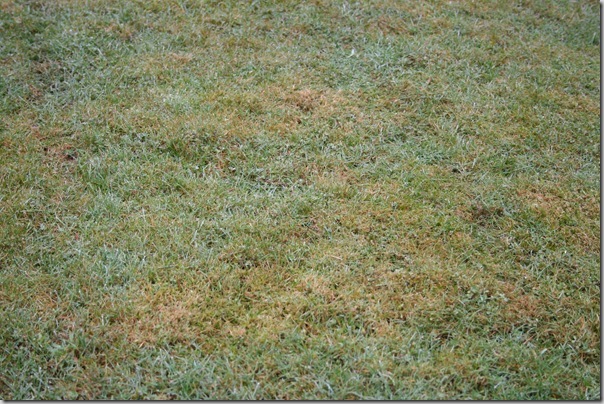
This is pretty sad, right? It’s all brown and unhappy, the grass is thin, and moss has taken over. Why fight nature? Lawn doesn’t like to grow in shade. And lawn prefers lime soil, so the acidic area under a pine or redwood tree is never going to be an ideal, happy parcel of frolicsome lawn.
Here are some tips on what to plant under a redwood or pine. Hint: not lawn.
If you really really want lawn under redwoods, or in the shade, here’s what you’ve gotta do. Impeccable care. Rake 1/2 inch of compost over the whole lawn each spring. Check your soil pH 1-2 times a year and treat with lime to keep it alkaline. Leave clippings and mow often so the clippings are small enough to easily decompose and add organic matter to the soil. Then add a mix of compost and grass seed to your lawn each autumn to help shore up any bare spots with fresh grass.
Even with all of that, it won’t be 100%. I’d advise that you get happy with what you’ve got, and enjoy the excuse to create some new planting beds for shade-loving plants.
How about you? Have you seen any horrible landscaping blunders that drive you nuts? Let me know in the comments below.
26 responses to “Don’t Do This: Horrible Landscaping Blunders”
[…] Genevieve Schmidt : North Coast Gardening : Arcata, CA Pin itFacebookTwitterStumbleUpon […]
Dog urine – you’re so right! After adopting our sweet ‘Buddy’ this year, I’m all too familiar with what plants survive being whizzed on. Never thought of the fine leaved plants holding on to it longer, but you’re right! Something to definitely consider for those folks who have whizzers like I do….
Rebecca, I’d love to pester you one of these days for that list of plants that can be whizzed on. I need it! My cats do no such thing, so I find myself wishing for a cheat sheet on the topic.
You’ve highlighted some great don’ts here, Gen, and some great solutions, too. Thanks!
Thanks, Jocelyn!
Bamboos aren’t quite the same runaways in our climate, but we do have our share of asphalt-eating thugs. So: right plant, right place. Works in any zone. Landscape cloth sins are pretty universal.
So true, Helen. I bet you have your own list of plants that eat the garden!
Great reminders, Gen. I admit to having a few clumping bamboos in my garden sans barriers. So far so good, but now I’m wondering… As for running bamboo, I’m too chicken to plant any, even in a container. 🙂
Pam, as Helen pointed out, maybe it varies by climate? Perhaps they’ll never be an issue? I know there is one bamboo that I’m comfortable using with no barrier – candy cane bamboo. Pretty and fairly well-behaved.
Bamboo is one of the biggest thugs around–people really don’t consider what’s going to happen in 3-5-10 years…they should!
Yep!! 🙂
Thanks for such a great post, and you make points I couldn’t fit in. Even the ones that don’t apply directly here, have a desert counterpart (bamboo heaving paving here is sotol or bird of paradise). Great stuff to chew on and expand off of! And in many cases, I say don’t even use fabric, edging, or lawn, as there are other methods of design and maintenance to avoid those so many times. The fabric exposed at the birch…yuck.
David, I couldn’t agree more on your points. I try not to use fabric, but it’s hard sometimes when people have it in their minds they definitely want to go that route. I’m curious about your suggestions for edging substitutes! I’d love to see you do a post on that soon. I’d love to know what you do, because I certainly have mixed feelings about edging.
Edging subs and ideas…good idea for a post; I’ll write that down, to do. A quite good article (visuals plus how-to) on that topic is in the lastes “American Gardener” by the AHS. I’ll send you the link, if I can find it.
In some ways, leaving out edging is easier in the desert, since many landscapes no longer have any turf. Our most suitable turf species have stolons and rhyzomes (Zoysia, Bermudagrass, Buffalograss), so it’s a challenge…where people use Turf-type Tall Fescue, with no runners, less of a challenge. Let me ponder…
Great distinctions about the need (or not) for using edging in different scenarios like with differing types of turf. I’ll definitely look for that article. Why am I not subscribed to The American Gardener? I think I’ll go fix that now. Seems like a good one.
OMG…thank you for this reminder of why I’m NOT planting bamboo in my tiny garden! I kind of waffle from time to time, but have to remind myself that even the clumpers are far too thuggish…especially in my small space.
You got it, Scott. I love bamboo in pots. 🙂
Its easy to say what not to do, less easy to provide solutions and here you do both. Great points!
Best
R
Thanks, Robert!
Just say “NO” to any kind of non-organic weed-barrier whether it be old school (black poly) or the contemporary landscape fabrics. Soils are nourished by decaying organic matter and the little critters that make that process happen. I want my soils enriched as naturally as possible, so every few years I like to work the old bark mulch into the soil and add a new top layer. This helps keep the weeds manageable and the soil healthy.
The only time those landscape fabrics are effective in fighting weeds is in a brand new planting to help reduce existing weed seed germination. After that, they are completely ineffective. People seem to forget that weed seeds are constantly introduced into our gardens and will germinate in whatever is on the inch or so of soil. Plus, have you ever wanted to re-work up an new area only to find someones old weed-barrier under years of mulch application? What a pain!
Now, on the other hand, I do like to use a good landscape fabric under stone pathways and such where I don’t want the rock work to become incorporated into the soil. This keeps the paths cleaner and helps them last longer while making it easier for future laborers to pull it out should someone decide to change the design.
Well, there’s a rant that has apparently been simmering under the surface for a while – thanks for the opportunity to allow this old guy to get his Grumpy out. :^)
Ed, could I possibly agree more with EVERY point you’ve made about landscape fabric? Rant on, my friend. I am with you!
Oh Genevieve, you really hit a hot button with me on this one. All of your points were spot on, but the Bamboo- that is one I fight and fight and fight every season at the nursery. Customers come in with this delicate vision of a bamboo privacy screen and then I go through the steps they need to take for planting, growing and maintaining it for this purpose. I purposely leave one VERY important question for last- Do you have acreage? They usually re-think it pretty quickly. I DO make sure to show them the clumpers, but when they see the price- it’s over pretty quick. 🙂
The funny thing is, all I can think about during the non-sales conversation is- “This is a potential Personal Garden Coaching client down the road when that Bamboo is up on the neighbors foundation!!!”
You’ve got the spiel DOWN, Christina! Awesome. Yes, it’s really hard when people have their hearts set on one specific type of plant. All we can do is share the information we have and hope they’ll make a decision that will make them happy years from now in addition to in the moment.
Chuckling at “Do you have acreage?”. Classic.
I was one of those people who are bent on getting bamboo for their garden. It kind of gives a zen-like feeling to a garden. I’d like to dedicate a big area for bamboo but never thought of it being a very invasive plant. I was surprised with the bamboo growing on concrete as well, and there i was thinking that weeds are the worst invasive plant out there. I’m still thinking of getting that bamboo as they can still be handy if ever they went rouge. Their trunks can be used as plot barriers, giving off a tropical, native feel for the garden. Thank you for this article, it gave me second thoughts about bamboo but its for the best as i wont regret whatever decision i make from here on out (regarding bamboo that is). Thanks again!
[…] Genevieve Schmidt : North Coast Gardening : Arcata, CA […]
[…] Don’t Do This: Horrible Landscaping Blunders […]